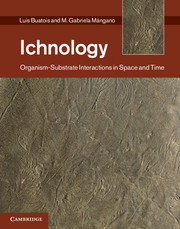Book contents
- Frontmatter
- Contents
- Acknowledgments
- Introduction
- Part I Conceptual tools and methods
- Part II Spatial trends
- 6 Trace fossils and paleoecology
- 7 Ichnology of shallow-marine clastic environments
- 8 Ichnology of marginal-marine environments
- 9 Ichnology of deep-marine clastic environments
- 10 Ichnology of continental environments
- 11 Ichnology of carbonate environments, rocky shorelines, and volcanic terrains
- Part III A matter of time
- References
- Index
11 - Ichnology of carbonate environments, rocky shorelines, and volcanic terrains
from Part II - Spatial trends
Published online by Cambridge University Press: 25 October 2011
- Frontmatter
- Contents
- Acknowledgments
- Introduction
- Part I Conceptual tools and methods
- Part II Spatial trends
- 6 Trace fossils and paleoecology
- 7 Ichnology of shallow-marine clastic environments
- 8 Ichnology of marginal-marine environments
- 9 Ichnology of deep-marine clastic environments
- 10 Ichnology of continental environments
- 11 Ichnology of carbonate environments, rocky shorelines, and volcanic terrains
- Part III A matter of time
- References
- Index
Summary
The pillars are forty-two feet in height; their surface is smooth and uninjured to the height of about twelve feet above their pedestals. Above this, is a zone, twelve feet in height, where the marble has been pierced by a species of marine perforating bivalve – Lithodomus, Cuv. The holes of these animals are pear-shaped, the external opening being minute, and gradually increasing downwards. At the bottom of the cavities, many shells are still found, notwithstanding the great numbers that have been taken by the visitors. The perforations are so considerable in depth and size, that they manifest a long continued abode of the Lithodomi in the columns; for, as the inhabitant grows older and increases in size, it bores a larger cavity, to correspond with the increasing magnitude of its shell. We must, consequently, infer a long continued immersion of the pillars in sea-water, at a time when the lower part was covered up and protected by strata of tuff and the rubbish of buildings, the highest part at the same time projecting above the waters, and being consequently weathered, but not materially injured.
Charles Lyell Principles of Geology (1830)Estoy sentado aquí en el atolón. Estoy sentado y plantado aquí en el atolón.
Luis Alberto Spinetta Holanda (1996)As mentioned in previous chapters, our ichnological knowledge of the different depositional environments is highly variable. For example, carbonates have received less attention than siliciclastics. Also, volcanic terrains have been little explored from an ichnological perspective. On the other hand, rocky shorelines, which fall within the realm of bioerosion, have been the focus of a number of detailed ichnological studies, both on modern and ancient shorelines. In fact, the study of bioerosion has a long history, starting with Lyell’s (1830) observation of borings produced by the lithophagid bivalve Lithodomus, which actually belongs in the ichnogenus Gastrochaenolites, pervasively bioeroding the marble pillars of the Temple of Serapis. In this chapter, we will explore the ichnology of this last set of environments. First, we will focus on carbonate rocks, addressing shallow-marine tropical carbonates, reefs, shelf and deep-sea chalk, and carbonate turbidites. Second, we will review our present knowledge of rocky shorelines. Finally, we will explore the ichnology of environments strongly affected by volcanism.
- Type
- Chapter
- Information
- IchnologyOrganism-Substrate Interactions in Space and Time, pp. 217 - 228Publisher: Cambridge University PressPrint publication year: 2011
- 1
- Cited by



